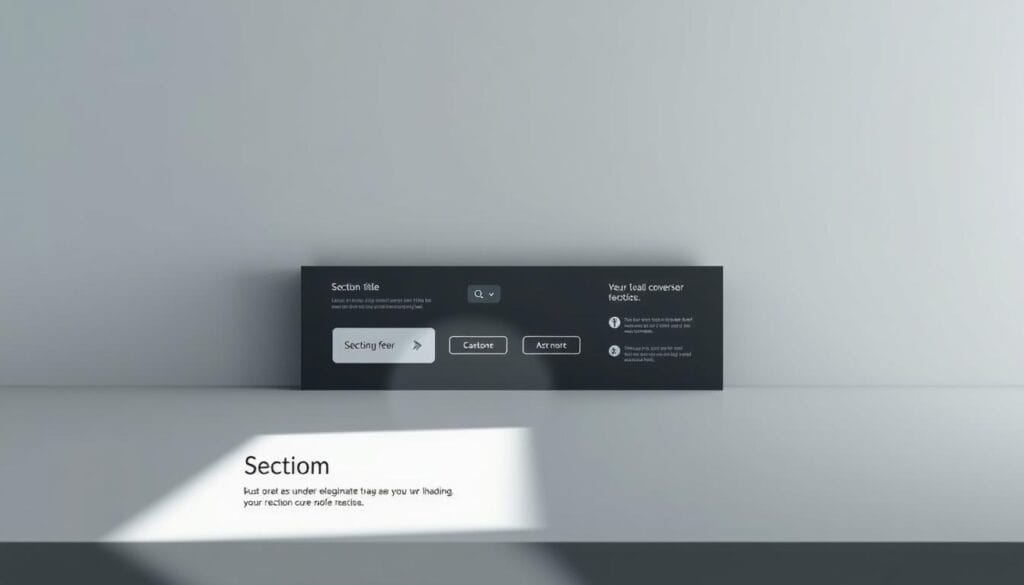75% of customers judge a company’s credibility by its website’s look and feel. In about 50 ms, a visitor forms an opinion that can sink or scale revenue. That first blink is the real leak for high-ticket brands: pages that look great but fail to convert.
We believe design and functionality are not enemies. They are levers. When aligned, they lift trust, lower CAC, and compound conversions.
Macro Webber builds systems that marry visual appeal with rigorous functionality. Our WebberXSuite and the A.C.E.S. Framework turn subjective choices into measurable outcomes—faster paths to value, higher CVR, and resilient mobile performance.
In this guide we use Forrester, Portent, and Google metrics to show what to fix first and how to test for scale. Expect clear, sprint-ready tactics that leadership can act on now.
Key Takeaways
- First impressions form in 50 ms—design influences credibility and pipeline quality.
- Well-engineered design plus solid functionality drives measurable ROI.
- Speed and Core Web Vitals directly affect conversion and ranking.
- Macro Webber’s frameworks translate aesthetics into conversion systems.
- Actionable, sprint-ready fixes beat vague advice—focus on tests that move revenue.
The hook: Why “pretty but poor” pages leak revenue in the present
Beauty can mask broken signals that drive qualified prospects away. In the present market, a polished screen can still fail the basic tests of clarity, credibility, and speed. That failure costs demos, drags out sales cycles, and inflates CAC.
First impressions in 0.05 seconds: trust, clarity, and bounce-risk
In 0.05 seconds, users form a take on your trust and credibility. If design and messaging miss, bounce risk spikes before any CTA appears.
Slow load time amplifies the problem. Sub-1s experiences convert 2.5–3× better; slow sites lose attention and rates drop.
High-ticket stakes: credibility, confidence, and qualified pipeline
- Aesthetics set early confidence, but poor functionality kills momentum.
- 38% stop engaging when a site looks or reads poorly; 88% won’t return after a bad experience.
- We align design to buyer psychology: reduce cognitive load and drive one dominant action above the fold.
We engineer quick credibility cues—social proof, outcomes, and compliance—so informed users convert with confidence.
Landing Page Aesthetics vs Function: reframing the false trade-off
Visual polish and operational clarity must serve a single business goal. We reject the idea that brand beauty and conversion are exclusive. When orchestrated, design and functionality compound toward measurable outcomes.
Balance is not vague. It is faster comprehension, fewer choices, a dominant CTA, and frictionless flow. We use the A.C.E.S. Framework—Attention, Clarity, Evidence, Steps—to align form with purpose.
Design elevates brand trust; function keeps momentum. Standard UI tokens—spacing, type scale, and color systems—translate visual cues into predictable behaviors across screens.
“Purpose-led heroes set the promise, quantify value, and make the next action obvious.”
Practical checks:
- One primary action above the fold; defer secondary paths.
- Microcopy maps voice to interface—directive and outcome-focused.
- KPIs: primary CTA CVR, time to first interaction, and misclick rate.

What the data says about design, usability, and conversion
Hard data shows that design choices become credibility signals before a single interaction. Decisions that look small—spacing, hierarchy, proof placement—shape whether users stay or leave.
Key evidence for leadership:
- Visual-first credibility: 75% of customers judge credibility by a website’s look and feel (Kinesis Inc). That trust gap cancels downstream pipeline growth.
- Compounding ROI: Forrester finds $1 in UX returns ~$100; UI and UX work can lift conversions up to 200–400% when executed to targets.
- Speed drives demos: Portent shows sub-1s loads convert 2.5–3× better. Slower site performance raises bounce rates and hurts Core Web Vitals ranking signals.
Focus improvements on the core metrics: LCP, CLS, and INP. Prioritize mobile-first rendering, edge caching, and trimmed JavaScript to protect conversion rates.
| Metric | Why it matters | Target | Leadership KPI |
|---|---|---|---|
| LCP | Perceived load speed sets attention | <2.5s (ideally <1s) | Time to first interaction |
| CLS | Visual stability reduces misclicks | <0.1 | Assist rate from trust sections |
| INP | Interactivity keeps qualified users | Good responsiveness | Demo request CVR |
Core principles: turning visual appeal into usable experience
Visual order is a conversion tool: when content breathes, users act with confidence. We treat design as a system that reduces doubt and channels action.

Visual hierarchy, spacing, and information density
Build a clear stack: dominant headline, subhead promise, proof, and one primary CTA. Protect that area with white space to lower cognitive load.
Typography and readability
Choose typography for role: sans for fast scanning, serif for authority. Lock down fonts, sizes, and line-height across breakpoints to preserve legibility.
Color and contrast
Use a single action color and restrained palette. Meet contrast ratios to support accessibility and raise conversion trust.
Navigation clarity
Simplify paths: one primary route per experience. Labels must be outcome-focused to keep momentum and reduce misclicks.
| Principle | Action | Conversion outcome |
|---|---|---|
| Hierarchy | Hero headline + proof + CTA | Faster first click on primary CTA |
| Typography | Standardize fonts, sizes, line-height | Better scanability and comprehension |
| Color & Contrast | Single action color; meet AA/AAA | Higher CTA visibility and trust |
| Navigation | One primary path; clear labels | Lower drop-off, improved demo requests |
The aesthetic‑usability effect: power, limits, and practical safeguards
A pleasing interface can raise tolerance, yet it cannot fix broken paths. Attractive visuals trigger an emotional response that makes minor friction feel smaller. That short runway helps first impressions and momentum.
Still, the effect has limits. Severe information gaps, poor pathfinding, or brittle flows override charm. When core tasks fail, users abandon intent regardless of polish.
Emotional response boosts tolerance for minor issues—until it doesn’t
Attractive design creates patience. Users forgive small hiccups and move forward more often.
But tolerance drops fast when tasks stall. That’s where conversions die.
Usability testing pitfalls: when “it looks great” hides real problems
In studies, praise can mask failures. Watch actions, not applause. Track time-to-task, misclicks, and rage clicks to spot hidden friction.
Research tactics: observe behavior, probe neutrally, separate form from function
- Separate visual skins from flows: A/B test identical funnels with different design treatments.
- Use neutral probes: “What made this easy or difficult to find?”
- Reduce politeness bias: tell participants candid feedback is vital.
- Instrument sessions: collect clicks, pauses, and completion rates alongside comments.
Guardrail: never trade critical functionality for cosmetic wins. Make sure aesthetics enhance clarity and information, not obscure it.
Function-led examples and when simplicity outperforms glamor
When clarity drives intent, minimal interfaces win consistently. Google’s homepage is a masterclass: one search input, one purpose, near-zero friction to action.
Craigslist and Hacker News prove the point. These sites favor clear information architecture and fast, readable feeds. High traffic follows simple utility, not ornament.
The lesson for leaders: prioritize functionality and speed over decorative layers that slow discovery.
- One intent, one input: reduce choices so the user moves immediately.
- Functional minimalism: strip nonessential elements that distract from the primary action.
- Progressive disclosure: keep the core experience lean; link deeper proof for those who need it.
- Protect load budgets: minimal scripts, optimized media, and restrained animations that don’t delay input.
“If a visual element doesn’t improve understanding or action, it doesn’t ship.”
Test the simplest viable variant first, set a performance baseline, then layer brand design iteratively. That way we win repeat visits and measurable conversion lift.
SEO meets UX: winning Core Web Vitals and ranking through experience
When search meets human behavior, technical UX becomes a competitive moat. We tie measurable user experience work to organic visibility so leaders can mandate outcomes, not guesses.
Page speed, stability, interactivity: signals Google rewards
Hit Core Web Vitals: target LCP <2.5s, CLS <0.1, and responsive INP. Optimize images, trim JavaScript, and defer noncritical assets to protect ranking and conversion.
Mobile-first experience: structure, content clarity, and internal linking
Design the primary flow for thumbs: large tappable targets, short forms, and persistent CTAs. Structure content with clear subheads and proof blocks to improve scan rates and engagement.
- Monitor field data (CrUX) to catch regressions early.
- Use internal links to guide users from hero claims to case studies and pricing without detours.
- Implement edge delivery, preconnect, and resource hints to speed above-the-fold assets.
“Real user experience is now table stakes for organic growth.”
| Practice | Why it matters | Expected impact |
|---|---|---|
| Core Web Vitals tuning | Improves perceived speed and stability | Fewer abandonments; better search placements |
| Mobile-first flows | Aligns with Google indexing and user intent | Higher engagement and conversion rates |
| Third-party audit | Removes hidden latency and risk | Millisecond gains that protect revenue |
Measure what matters: diagnostics for aesthetics and functionality
A rigorous diagnostics kit separates pretty visuals from real usability gains. We build a compact playbook that leaders can run in sprints to prove impact and avoid vanity wins.
Quant: core funnel signals
Track conversion rates (CVR) on the primary CTA, CTR on headline actions, time to first interaction, and scroll depth to valued sections. These metrics tie design and load budgets to business outcomes.
Qual: uncover hidden friction
Layer moderated studies, task success rates, misclick counts, hover hesitation, and rage clicks. Positive visuals can bias feedback; observe behaviors and task completion to reveal true usability issues.
Benchmarking and statistical discipline
Use cohort splits, before/after tests, and declare minimum detectable effects with confidence intervals. Map lifts to lead quality, SQL rates, and sales velocity so the site work translates to revenue.
- Dashboards: alarm on CLS spikes, speed regressions, or interaction delays.
- Governance: templatize winners, retire poor designs, and enforce the balance between appeal and task success.
- Cadence: set quarterly goals for conversion, engagement, and core Web Vitals; review in sprint rituals.
“Measure the signal that predicts revenue, not the applause that flatters design.”
| Signal | Why it matters | Leadership KPI |
|---|---|---|
| Primary CTA CTR | Shows intent to convert | Qualified lead rate |
| Time to first interaction | Reflects perceived clarity | Demo request velocity |
| Misclick / rage clicks | Reveal information gaps | Task success rate |
Best practices checklist and Growth Blueprint handoff
Make the final handoff practical: a checklist leaders can act on this week. We package design and technical requirements into a compact growth playbook so teams ship results, not opinions.
Must-haves
- Purpose-led hero that quantifies value and sets expectations.
- Focused messaging that earns attention and reduces cognitive load.
- Single primary CTA to drive one clear outcome and measurable goals.
Design guardrails
- Consistent design tokens and style system for repeatable brand visuals.
- Accessible color contrast, readable fonts, and disciplined space.
- Typography choices that speed scanning and improve clarity.
Functionality first
- Fast loads and Core Web Vitals tuning to protect conversion and search.
- Clear navigation that prioritizes one journey per experience.
- Resilient forms with autosave, inline validation, and error paths that keep users moving.
- Continuous usability testing and session replays to separate visuals from task success.
- Iterative sprints that fix the highest-impact issues first.
- Codify wins: retire underperformers and enforce a release checklist tied to conversion goals.
Handoff: We implement Macro Webber’s Growth Blueprint to systematize these ways across teams and sites. This converts tactical fixes into long-term lift and predictable velocity.
“Ship only what moves conversion and brand trust—then iterate with data.”
Book a consult now. Onboarding slots are limited. Secure a leadership-ready roadmap and lock in your implementation window.
Conclusion
The smartest websites turn visual appeal into measurable demand, not just applause. We design with intent so attention becomes action. Good design and reliable functionality work together to move users toward one clear outcome.
Users form credibility judgments in about 50 ms. Visual appeal must make value obvious, not hide it. Balance matters: beauty earns attention; strong flow converts it.
Usability is nonnegotiable. When core tasks fail, no polish rescues the brand or the product. Treat your website as the first product buyers use and invest the same rigor.
Test, observe, and measure. Expect compounding gains when interfaces, content, and systems align on one purpose. Macro Webber builds that system end-to-end—strategy, design, development, and optimization.
Now is the time: book your Macro Webber consultation to secure a spot in our Growth Blueprint rollout. Capacity is limited; high impact starts with a decision today.



